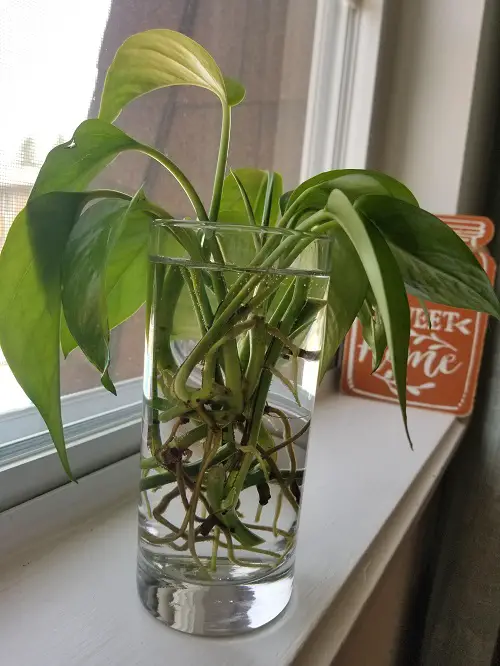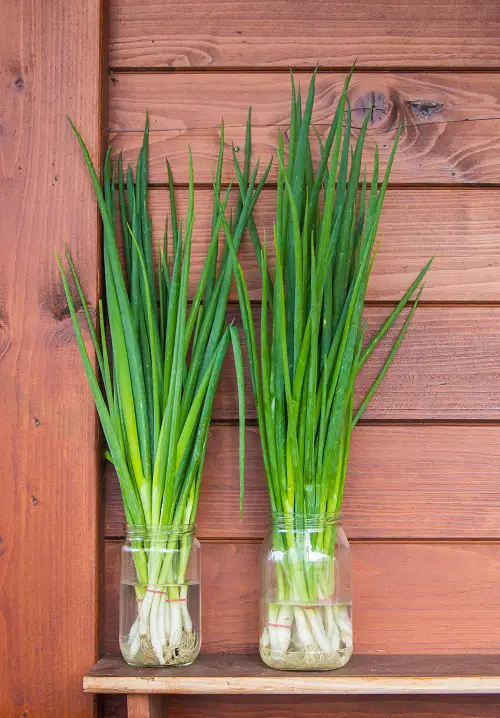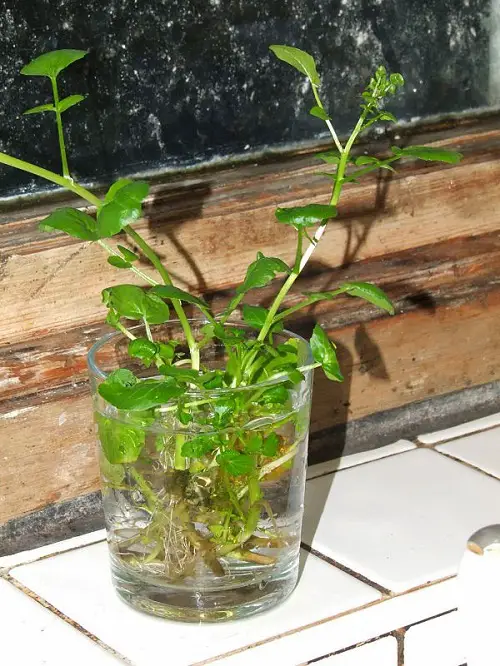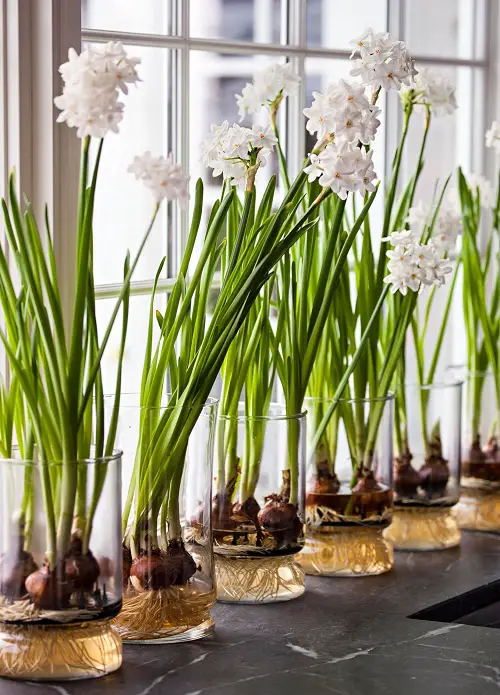Here are the most Useful Plants to Grow in a Jar of Water so you can reap the benefits with little prep and care!
If you forget to water your plants more often than not or are just averse to handling dirt and soil too often, we have got you covered. Listed below are the most useful plants to grow in a jar of water so you can enjoy your gardening hobby without much maintenance.
Useful Plants To Grow in Water
Most of these plants can be grown in water until they grow roots about two inches in length. After that, you can transplant them into the soil or continue growing some of them in the same growing medium. You must also change the water of these plants every three to five days.
1. Basil

Botanical Name: Ocimum basilicum
For a continuous supply of fresh basil without even using soil, choose basil cuttings with at least two nodes, stick them in a jar of water, and make sure the nodes are submerged. Here are the detailed steps.
As long as you give this plant a well-lit spot to grow and change water frequently, you can harvest and use the fresh leaves for cooking and a dozen medicinal purposes!
2. Garlic Greens
Botanical Name: Allium sativum
Garlic greens are an amazingly flavorful addition to risotto, salads, soups, and pasta. You can also mix the scapes with other ingredients to make condiments to supplement your main courses.
To learn how to grow garlic greens in water, just follow this for more details.
3. Mint
Botanical Name: Mentha
Similar to growing basil, mint cuttings need to have two nodes submerged in water before they start showing roots in a week. After about ten days, the roots begin to get longer.
Mint grows best in full sun, but in water, you must provide it with full-day indirect sunlight. Here’s the full guide to growing mint in water.
Mint can be used in garnishes in drinks and desserts to help with digestive issues. This versatile herb is the perfect addition to your indoor plant collection.
4. Chives
Botanical Name: Allium schoenoprasum
If you love to use chives as a garnish for their slightly onion-like flavor, add them to your hydroponic plant collection. Chives are super easy to grow in a vase of water; you just submerge the base of the chives to let the plant grow.
5. Nasturtium

Botanical Name: Tropaeolum majus
Propagating nasturtiums from cuttings in soil or water is even faster than seed propagation and perfect for gardeners who don’t like to wait. Plus, all parts of the plant except the roots are edible and have a slight peppery flavor. It also has these benefits and uses.
Use RO water as tap water may contain chlorine, which is not good for water propagation.
6. Cilantro

Botanical Name: Coriandrum sativum
You could grow cilantro hydroponically from cuttings. When growing with cuttings, the process would be similar to that of growing basil. Add some peat moss and pebbles to the container to stabilize it (cilantro grows vertically), or use a jar with a narrow neck.
7. Pothos

Botanical Name: Epipremnum aureum
One of the easiest plants to grow in water, pothos won’t just grow in water; it can become a big vine. To grow this plant in water, you must first get cuttings that include at least one node from where roots can grow.
Provide ample, bright, indirect sunlight, but not too much, which can burn the foliage. Try these ideas for some stylish display.
8. Watercress
Botanical Name: Nasturtium officinale
To grow watercress in a jar of water, use healthy stem cuttings from a mature plant.
Watercress generally prefers flowing water, so ensure that you change the water in the jar in 3 days.
9. Water Hyacinth
Botanical Name: Eichhornia crassipes
Hyacinths in a jar of water can quickly grow if kept in a cool, dark place without sunlight. Ensure that the roots are submerged while the bulbous part remains above water. It’ll spread quickly, so you may need to keep removing extra growth to maintain the beauty of your hyacinth vase.
10. Peace Lily
Botanical Name: Spathiphyllum wallisii
Like a few other indoor plants, Peace Lily can survive easily in low light, and it purifies the air as well.
One of the main points to remember when growing a peace lily in a jar of water is to keep the crown of the plant above water. Peace lily does not favor normal tap water, so use RO water or rainwater.
11. Lemongrass

Botanical Name: Cymbopogon citratus
A quintessential ingredient in most Southeast Asian cuisines. It can be used in making DIY lemongrass essential oil, which is also a good insect repellent!
Put a lemongrass stalk in a jar with an inch or two of water. Ensure that the bulb faces down. Lemongrass prefers warm temperatures and full sun, but in water, just keep it in the shade and provide bright light.
After you provide these conditions for around three weeks, you will start to see new roots and leaves. That’s the time to transplant it and wait for harvest.
12. Carnations
Botanical Name: Dianthus caryophyllus
Carnations are a popular cut flower choice for aesthetic purposes in flower vase arrangements. Though not as easy to grow in a jar of water as the plants listed above, you can still try it as an experiment.
13. Amaryllis
Botanical Name: Amaryllis
Amaryllis can be grown quite easily in a jar of water as long as the bulb is not drowned. Choose a jar slightly bigger than the bulb with a narrow neck and pour in pebbles and gravel.
Then, pour in some water (about 4 inches of the jar’s height) and adjust the bulb over the neck in a way that only the base is touching the water.
Roots must be in contact with the water, not the whole bulb, or you might see rot. Once the bulb flowers, you can dry it and use it as a remedial laxative or diuretic.
14. Paperwhite narcissus
Botanical Name: Narcissus
To grow narcissus in water, anchor its bulb in the jar using stones such that the flowers don’t tip over. You could also use marble chips, tumbled glass, marbles, and polished river stones to cover the bottom half of the bulb. The water should only touch the base of the bulb.












Thank you,
I didn’t know that you could grow so many plants in water.